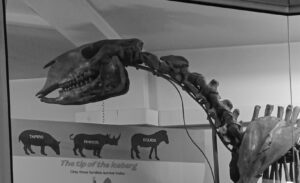
Moropus skeleton. IMAGE: Matt Colborn.
The first “anti-depressant” I ever took was called Imipramine. The pills were circular and maroon. Imipramine is a tricyclic anti-depressant. Common side effects included a dry mouth (yes), dizziness (yes), urinary retention (yes), and nausea (yes). This was in May 1998, in Birmingham. I was working at the Birmingham University Field Archaeology Unit, and over Winter, I’d fallen into a serious depression. I was worn out, desperate, exhausted, and at the end of my tether. A psychiatrist said I had a “chemical imbalance” and needed the medication to boost serotonin in my brain. At the time, it never occurred to me to question this narrative.
Discovering Gaia
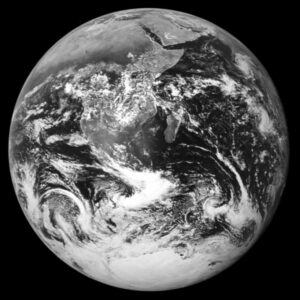
Blue Marble. IMAGE: NASA.
Flashback ten months:
In September 1997, I’d completed a Masters in cognitive science and had been awarded a distinction. This was one of the high points of my life. I’d thrown myself into the course, and fallen in love with the subject. Cognitive science is a multidiscipline — a convergence of cognitive psychology, artificial intelligence, philosophy of mind, neuroscience, linguistics and anthropology. One aim is to understand thinking in human beings. Another is to use artificial intelligence to better understand that thinking. Over the course, I’d especially become interested in Artificial Neural Networks — computer programs that mathematically mimicked the working of brain cells, and could actually learn.
In the summer of 1997, as I completed my dissertation, I had begun to think about a doctorate in the subject. I had the future all mapped out. I’d complete a doctorate and have an exciting career in cognitive science. I felt eager, enthusiastic and very committed. Cognitive science was a pioneering topic. One of my tutors had compared our knowledge of the mind to that of Galileo’s understanding of physics. So we had an exciting journey of discovery ahead.
But I’m also a rotten specialist. I do not believe that knowledge should exist in silos. So I used the resources available to me to indulge my wider curiosity. I especially wanted a better understanding of life’s place in the universe. This would help me to better understand cognition in context. Birmingham library had a wealth of material, and I dived in.
Two key influences were James Lovelock and Lynn Margulis. These scientists had been responsible for what became known as Gaia theory. Gaia was the idea that the whole Earth operated as a planet-sized entity; in other words, that in some sense, the Earth should be considered alive. Lovelock defined Gaia as a “Complex entity involving the Earth’s biosphere, atmosphere, oceans and soil; the totality consisting a feedback or cybernetic system which seeks an optimal physical and chemical environment for life on this planet” (Lovelock 1979/2016, p. 10). The name, Gaia, after the ancient Earth goddess, had been suggested by the author William Golding.
Jim Lovelock was already familiar to me, Lynn Margulis was not. She was a biologist who specialised in microorganisms and was also a “vindicated heretic.” In the 1960s, she’d pushed forward the idea that the energy factories of the cell — the mitochondria — had originated as free-swimming bacteria and become incorporated after being eaten. At the time this theory was ridiculed, but eventually, Margulis was proved right. I first came across her in an interview where she discussed Post-Darwinism — theories that went beyond Darwin’s theories of evolution. Later, I picked up some of her books. She had a completely fresh take on biology. Most of the books I’d read had focussed on large animals and plants with many cells — multicellular organisms. For Margulis, this focus was all wrong: it was the microorganisms that mattered. Over the four-billion-year period of the planet, the microorganisms, especially the bacteria, had kept the whole Earth system of Gaia running. Microorganisms had created the oxygen atmosphere that we breathed, and they performed many key functions upon which all life on Earth still depended.
This understanding was for me more than a crucial lesson: it was a profound paradigm shift. It was a vision of biology that was for me far more interesting than that found in the writings of authors like Richard Dawkins. We weren’t just selfish replicators: we were part of a larger, world-encompassing, symbiotic system. We were also, in the words of Margulis, “walking communities of bacteria.” (Margulis & Sagan, 1986, p. 191). So this period was for me a time of tremendous intellectual ferment and growth.
So what went wrong?
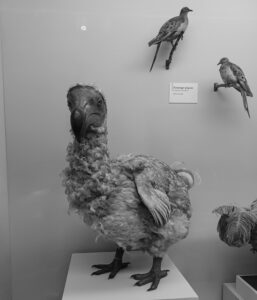
Dodo. IMAGE: Matt Colborn.
Looking back, many things.
I’ve no doubt that a significant portion of my depression stemmed from traumatic experiences in childhood and especially adolescence. There were a number of things I’d not really worked through by the time I reached my early twenties. I have also always been very sensitive to overstimulation and stress: I suspect that I’m what Elaine Aron has called a “highly sensitive person.” This has upsides but leaves me vulnerable to burnout.
This vulnerability had already manifested itself in slumps. I’d had several periods of ongoing, clinging anxiety and fear through late adolescence and into early adulthood. Often these worrying times would end with total exhaustion. Everyday life would become overwhelming, appearing utterly meaningless. At these times it was as if reality had become drained of vitality. What was left was a dead, tomb-like world.
But even in better times, I never felt quite stable. The best way that I can describe this is that I never really felt that I was standing on the ground. It was like I stood permanently on a tightrope, one wobble away from disaster.
So it probably just took a certain combination of circumstances to fall into a severe depression. After the end of the Masters, I moved back home for a few months. On the Winter Solstice of 1997, I got lost on the fens while driving back from Peterborough. It was dark and I was feeling increasingly panicked. There was ice on the roads. Snow driving into the windshield, I took a corner too fast and the car flew in and out of a dyke. Shaking, I got out of the car. It was cold, and dark and I had no phone.
I walked along an empty road in the direction of some lights. I came to a wire-mesh fence with a gate. A German Shepherd was barking. I called for help and a man with a flat cap came out. I explained what had happened and he ushered me into a kitchen. There was a woman at the kitchen table, and a couple of adolescent kids lounging in chairs. There were about five cats, and several dogs milling about. The dogs ranged in size from the German Shepherd to a small one like an animated dish-rag that settled on my lap.
It turned out that I’d stumbled into an Exotic Pet Refuge. The refuge rescued exotic pets people didn’t want anymore. The man told me they even had a jungle cat. When I went into the front room to telephone my parents, there was a marmoset asleep in a cage.
The man drove out to the car and when he returned he reached out to shake my hand.
“You, sir, are very lucky,” he said. The car had not flipped when it crashed in the dyke. If it had, I could have been seriously injured or killed.
After this incident, it was downhill all the way.
I moved back to Birmingham in February to live with some friends in a shared house in Moseley. Soon I was working at the Archaeology Field Unit. We were doing rescue archaeology at a sight called Dirft, near Daventry. This meant spending the weekdays staying at various B & Bs and during the days excavating a massive, muddy site that had once been fields. The site was going to be an international rail freight terminal. We were doing rescue archaeology — excavating an Iron Age settlement, which meant for the most part digging deep trenches in clay-rich soil. This soil was acid and had corroded many of the fragments of artefacts we found — mostly bits of pottery and animal bone.
The weather was very cold and it often rained. One day my head got so cold that I actually felt slightly high. But I liked the people that I worked with. I remember one day in the mini-bus after an especially hard day, when we were all saturated from heavy rain, we sang, to the tune of Finley Quaye’s “Your Love Gets Sweeter ,” “Dirft gets shi**er everyday!” It was a tough excavation.
And the doctoral applications weren’t going well. So far I hadn’t found a funded place. And the interviews so far were hardly inspiring. I’d had an interview with one academic who scolded me for daring to question the “information processing paradigm” of human psychology. Another potential supervisor had come across as uninterested, almost apathetic. I walked away from the first interview feeling deflated and from the second feeling demotivated. As the Winter gave way to Spring, I began to wonder whether I really wanted to do a doctorate, after all. Any momentum from the Masters had been lost.
This triggered a storm of worry in my head. My future had become anything but clear. I started spending the days that I was excavating overthinking that future. By the end of the day, not only had I failed to solve any of my problems, but I’d also managed to exhaust myself with increasingly panicked ruminations. The end result of this was a sort of ongoing mental paralysis.
The ecological factor
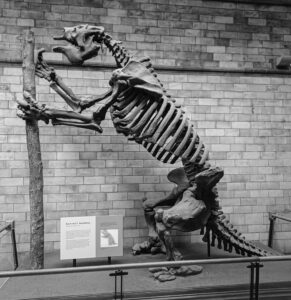 Megatherium skeleton. IMAGE: Matt Colborn.
Megatherium skeleton. IMAGE: Matt Colborn.
There was an also ecological factor.
Working as an excavator on a rescue site had given me a front-row seat on the destructive nature of our extractive economy. There was a meadow at the top of the site, inhabited by some chestnut horses. In early summer, the meadow was lush, green, beautiful, and dotted with wildflowers. The excavation was anything but beautiful and it was going to be further trashed by the construction of the terminal.
This made explicit an often implicit agreement to which we all to some degree consent. This agreement is that in an extractive economy, for human society to benefit, then the land has to suffer. Technological humans win, and nature loses. This transaction was an inevitable side-effect of economic growth. Piece by piece, we were slicing up the natural world. But in the words of the great biologist E.O. Wilson, nature was suffering from a death of a thousand cuts (Wilson, 2002).
This was happening globally, with accelerating speed. From 1997—8, fires in Indonesia combined with industrial pollution and exhaust fumes created enormous clouds of choking haze that spread over a vast area of Southeast Asia. The fires were dubbed a “planetary disaster” by the WWF, especially for their impact on the lowland tropical rain forests of Sumatra and Borneo. These fires were exacerbated by natural causes — it was an El Niño year, and forest fires are a regular occurrence in the tropical forests.
But these fires were anything but natural. The Indonesian government had an active program to “convert” primary forest into farmland. This was done by forest clearance and burning. The problem was that intensively logged “conversion” forest was often far more flammable than primary forest. About 80 per cent of the fires had occurred adjacent to plantations and timber concessions. There was also a scandal because it turned out that the fires were likely caused in part by wealthy plantation owners and timber barons. This was illegal but poorly policed. By March 1998, only five of the logging firms had been prosecuted. In Malaysia, 17 companies were fined a mere $8,000 for ignoring the no-burn policy.
News of those terrible fires simply appalled me. I had visions of crazed men in pin-striped suits bellowing with laughter as they raged through primary forest with a flamethrower. It was no longer possible for me to ignore the highly destructive nature of human technological society. It showed me that the rationalisations that we produced to justify our often-terrible behaviour were paper-thin. That Margulis had been right to ear-mark our “literally fantastic” capacity for denial and self-deception, the self-deception that enabled a “pandemic” of “deforestation, desertification” that was retrospectively labelled “progress” (Preface to Harding, 2009, ebook).
I was also becoming more aware of the bigger picture: namely, the prospect that our activities would trigger the sixth mass extinction. The fires had threatened many species, including orang-utans. I’d picked up Richard Leakey’s The Sixth Extinction, where he discussed past mass extinctions and the prospect of a human-induced sixth (Leakey & Lewin, 1995). He also quoted from an essay written by Edward O. Wilson,’ which was appropriately titled “Is humanity suicidal?” In this, Wilson presents one possible, grim picture of the human species:
“Even with most societies confined today to a mostly vegetarian diet, humanity is gobbling up a large part of the rest of the living world….everywhere we pollute the air and water, lower water tables and extinguish species…. The human species is…an environmental abnormality. It is possible that intelligence in the wrong kind of species was foreordained to be a fatal combination for the biosphere. Perhaps a law of evolution is that intelligence usually extinguishes itself.” (Wilson, 1993).
Wilson’s essay still makes essential reading today. And in fact, his view was that we were not suicidal as a species. He believed us “smart enough…to avoid an environmental catastrophe of civilization-threatening dimensions. (op.cit).” I wonder whether he’d still be this confident in 2022, when the Secretary-General of the UN has raised the same question.
Depression: an alternative view
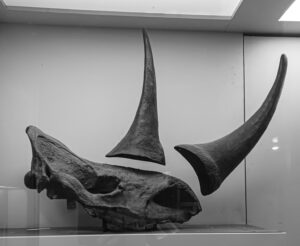
Fossil rhino skull. IMAGE: Matt Colborn.
This brings me back to the source of my depression. Looking back it’s so obvious that the “chemical imbalance” theory was very implausible. In fact, it’s been admitted on multiple occasions that the “chemical imbalance” story was never really more than a sort of psychiatric fiction. The weakness of the theory has been confirmed by a recent review of the evidence, led by Joanna Moncrieff.
More recent theories have focussed instead on brain function and may prove more viable. For example, there have been suggestions that the obsessive overthinking (“rumination”) that’s common in depression is linked to an overactive ‘Default Mode Network’ in the brain. And yes, I have a tendency to obsessively overthink things when stressed. But I don’t think that this demonstrates that my depression is a “brain disease.” The overthinking is more likely an outcome of (1) being a very ‘chatty’ person and (2) having had an education that was heavily focused on verbal, analytical thought. My tendency to overthink is likely the product of ingrained mental habits, habits that have worn deep neural grooves in my brain. Maybe it’s the academic equivalent of miner’s lung.
Both the chemical imbalance and abnormal brain function stories feed into a narrative about mental distress that locates the problem within the person. Treatments, likewise, are individualised: think cognitive behavioural therapy, drugs, electroshock, surgery, chip implants for Deep Brain Stimulation. The basic logic of all these treatments is the same. Discover the problem within the person, and use various medical interventions to “solve” or “repair” that problem.
Recently, there’s been some acknowledgement of the shortcomings of individualised approaches. The British Psychological Society’s 2020 report sees depression as a common experience that can arise for a variety of reasons, including social and contextual ones. So the fact that we live in an unhealthy “depressogenic” society matters. So does the fact that we’re living through potentially catastrophic climate change.
But the “atomised individual” story dies hard. There are very likely cultural reasons for this. James Davies, an academic and psychotherapist who has worked within the NHS, suggests that modern capitalism has a lot to do with this. In consumer culture “you only have yourself to blame” for your problems (Davies, 2021).
This insistence on an individual focus obscures a far more plausible view. This is that we’re embodied beings who are deeply embedded within an ecology. So
“….we respond beneficially to natural environments because our bodies are themselves natural. We are not only interconnected with our environment, our well-being is dependent upon it: as an integral part of the system, the needs of the person and the planet are a continuum…. (Stevens, 2010, p. 266).”
This alternative view turns the “atomised person” view of depression and wellness on its head. If our “well-being” is actually dependent on the natural environment, and if that natural environment is under daily, significant threat, then feelings of depression and anxiety would be understandable responses, not pathologies.
This ecological view also undermines the entire logic of the extractive economy. It shows that the often-hidden claim that for humans to benefit, nature must suffer, must be false. In fact, it shows that the opposite is true: that a healthy human depends upon a healthy ecology.
This seems obvious once it is pointed out. In fact, almost a truism. But we live in a culture that has worked very hard to obscure that truism. The myth of the atomised individual is a masking of that truth. Think about that the next time you hear a public official, billionaire or politician attempt to justify yet another piece of ecological destruction in the name of “jobs”, “growth” or “progress.”
References
Davies J (2021) Sedated: how modern capitalism created our mental health crisis. Atlantic Books
Harding, S. (2009). Animate Earth: science, intuition and Gaia (2nd. ed). Green Books.
Leakey, R. & Lewin, R. (1996). The Sixth Extinction: Biodiversity and its survival.
Lovelock, J. (1979/2016). Gaia. Oxford University Press.
Margulis, L. & Sagan, D. (1986). Microcosmos: Four Billion Years of Evolution from Our Microbial Ancestors. University of California Press
Stevens, P. (2010). Embedment in the environment: A new paradigm for well-being? Perspectives in Public Health 130(6), pp. 265—269.
Wilson, E.O. (2002) The future of life. Little, Brown.
Wilson, E.O. (1993). Is Humanity Suicidal? New York Times Magazine, May 30, 1993. URL = http://large.stanford.edu/publications/coal/references/wilson/
